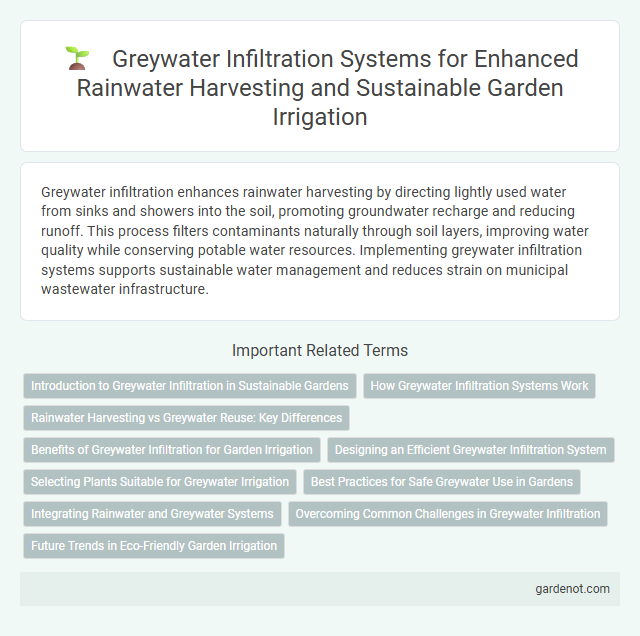Greywater infiltration enhances rainwater harvesting by directing lightly used water from sinks and showers into the soil, promoting groundwater recharge and reducing runoff. This process filters contaminants naturally through soil layers, improving water quality while conserving potable water resources. Implementing greywater infiltration systems supports sustainable water management and reduces strain on municipal wastewater infrastructure.
Introduction to Greywater Infiltration in Sustainable Gardens
Greywater infiltration in sustainable gardens involves the controlled dispersal of lightly used household water, such as from sinks and showers, into the soil to augment irrigation without contaminating groundwater. This method boosts water efficiency by recycling water on-site, reducing dependence on potable water sources, and supporting plant health through nutrient-rich irrigation. Proper filtration and treatment of greywater prevent soil salinization and protect the ecosystem within rainwater harvesting systems.
How Greywater Infiltration Systems Work
Greywater infiltration systems treat and redirect lightly used household water from sinks, showers, and washing machines into infiltration trenches or beds, allowing it to percolate naturally into the soil. These systems use filtration media such as sand or gravel to remove contaminants before water is absorbed underground, reducing surface runoff and recharging groundwater. By maintaining soil moisture and minimizing pollution, greywater infiltration supports sustainable rainwater harvesting and water conservation practices.
Rainwater Harvesting vs Greywater Reuse: Key Differences
Rainwater harvesting collects and stores rainwater from rooftops for non-potable uses, enhancing water conservation by reducing reliance on municipal supplies. Greywater reuse involves capturing wastewater from sinks, showers, and laundry, which requires treatment before infiltration to prevent contamination and health risks. Both methods contribute to sustainable water management but differ in source, treatment requirements, and applications, with rainwater being cleaner at collection and greywater needing more rigorous filtration for safe reuse.
Benefits of Greywater Infiltration for Garden Irrigation
Greywater infiltration for garden irrigation reduces freshwater consumption by recycling lightly used household water, enhancing overall water efficiency. This method improves soil moisture levels and promotes healthier plant growth by providing nutrients found in greywater, such as nitrogen and phosphorus. It also decreases the burden on municipal wastewater systems, contributing to sustainable water management practices.
Designing an Efficient Greywater Infiltration System
Designing an efficient greywater infiltration system involves selecting appropriate infiltration media such as gravel, sand, or engineered soil to maximize percolation and minimize contamination risks. Key considerations include sizing the infiltration basin based on household greywater volume, ensuring proper filtration to remove solids and contaminants, and incorporating vegetation to enhance natural treatment processes. Implementing overflow controls and routine maintenance protocols helps sustain system performance and prevent groundwater pollution.
Selecting Plants Suitable for Greywater Irrigation
Selecting plants suitable for greywater irrigation involves choosing species that tolerate higher nutrient levels and occasional salts present in greywater. Native and drought-resistant plants like lavender, rosemary, and ornamental grasses thrive with greywater, promoting sustainable water use. Avoiding edible crops and sensitive plants reduces health risks and ensures effective greywater infiltration in rainwater harvesting systems.
Best Practices for Safe Greywater Use in Gardens
Greywater infiltration in gardens requires careful management to prevent health risks and environmental contamination. Best practices include using biodegradable soaps, directing greywater away from edible plants and roots, and ensuring proper soil filtration to break down contaminants effectively. Regular maintenance of plumbing and irrigation systems reduces pathogen buildup, promoting safe and sustainable reuse of greywater for garden irrigation.
Integrating Rainwater and Greywater Systems
Integrating rainwater and greywater systems enhances water conservation by maximizing onsite water reuse and reducing demand on municipal supplies. Greywater infiltration allows treated household wastewater to replenish groundwater, complementing rainwater harvested from roofs and surfaces. Combining these systems optimizes irrigation efficiency, minimizes stormwater runoff, and supports sustainable urban water management.
Overcoming Common Challenges in Greywater Infiltration
Greywater infiltration faces challenges such as soil clogging, contamination risks, and fluctuating water volumes that impede efficient system performance. Implementing pre-treatment methods like filtration and sedimentation significantly reduces suspended solids and pathogens, enhancing infiltration rates and protecting soil health. Regular maintenance protocols and adaptive system designs tailored to local soil types and usage patterns ensure sustainable greywater reuse and groundwater recharge.
Future Trends in Eco-Friendly Garden Irrigation
Greywater infiltration systems are evolving with advanced filtration technologies that enhance water quality and soil health for sustainable garden irrigation. Integration of smart sensors and AI-driven controls is optimizing water distribution based on real-time soil moisture and weather data, reducing water waste. Future trends emphasize eco-friendly materials and decentralized collection systems to promote resilient, low-impact irrigation infrastructures.
Greywater infiltration Infographic

 gardenot.com
gardenot.com